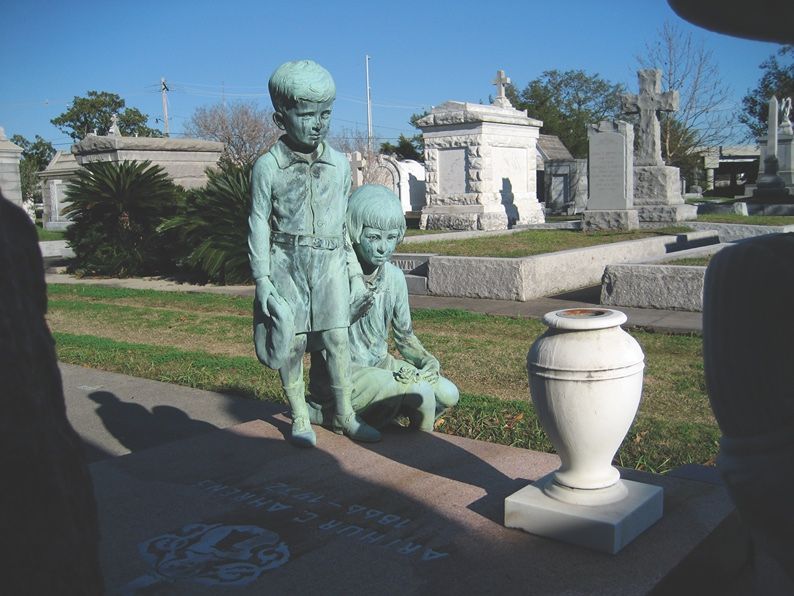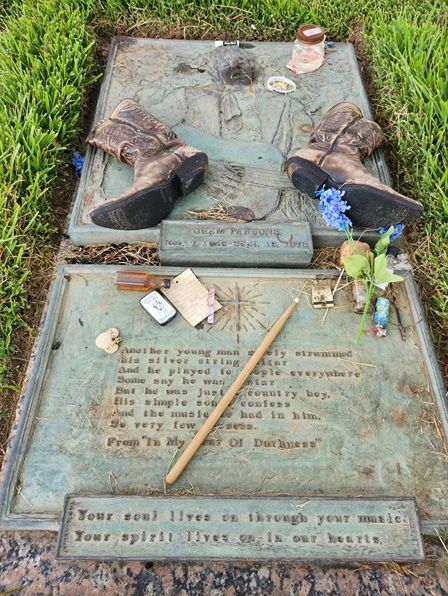NOLA holds a unique reverence for our dearly departed citizens.
The dead of New Orleans' permanent homes made of stone and brick peacefully sit right next to the homes of the living. It's not uncommon to encounter a walking tour or two sweeping through the cemetery as burials are happening.
During certain times of the year, you can join a marathon through a graveyard. Some of the colorful characters that have lived here brought their intriguing stories with them to their final resting place, and these graves are a sight to behold.
Inspiring Musicians
New Orleans is, of course, the birthplace of jazz, and the genre keeps people coming here. While the names of artists such as Louis Armstrong and Danny Barker are omnipresent, the musician that inspired them is not quite as well known.
Charles Joseph "Buddy" Bolden was a prominent cornetist in New Orleans in the first years of the 1900s. He played an unprecedented mix of ragtime, blues, and gospel, often adding his own improvisations to it. When he was only 30 years old, Buddy suffered dementia praecox (schizophrenia) and was admitted to the Louisiana State Insane Asylum. He lived here for more than 20 years until his death in 1931.
Due to his impoverished status, Buddy Bolden was interred in an unmarked grave in Holt Cemetery, an indigent cemetery located next to what became Delgado Community College's campus. While the exact location of Buddy's remains is unknown, Delgado Community College honored the progenitor of jazz with a jazz funeral and proper headstone in 1996 which includes Jelly Roll Morton's quote, "The blowingest man since Gabriel." This is also the cemetery where you'll find drummer Jessie Hill, grandfather of James Andrews and Troy "Trombone Shorty" Andrews.
Cemetery Things

Many prominent New Orleanians came to nearby Metairie Cemetery for eternal rest. Tom Benson, Ruth Fertel, Anne Rice, and Al Copeland are some of the more well-known residents. Among the somber graves, you'll come across one that's a bit more cheerful. Musician Louis Prima's grave features the descriptor "A Legend" followed by his song lyrics. You can't help but sing along when you read, "When the end comes, I know, they'll say, 'Just a gigolo;' life goes on without me."
St. Roch Cemeteries 1 and 2 were established in 1874 in the Bywater neighborhood. In the center of St. Roch Cemetery 1, a small chapel sits and allows those in need of healing to send prayers to St. Roch. The chapel was commissioned by Rev. Thevis in gratitude for St. Roch's intercession for sparing his congregation during the yellow fever epidemic of 1867. As you gaze upon the altar of the chapel, you'll be looking at the grave of Rev. Thevis who is interred under the floor at the foot of the altar.
In addition to the chapel that serves as the National Shrine of St. Roch, people have brought items including glass eyes, prosthetic limbs, plaster casts of afflicted, now healed body parts, and other tokens that serve as thanks for St. Roch's intercessions.
Storyville's Legacy
While citizens love to uphold long-standing traditions and enjoy teaching newcomers about them, the legend of Storyville is not as widely told. The 19-year-long era of legalized vice in a notorious red-light district called Storyville was considered a decadence best left forgotten when it ended in 1917. Though numerous women and men met their demise here through violence, disease, and self-inflicted means, it has been difficult to locate the final remains of most of its residents.
One of the most notorious madams of Storyville was Josie Arlington. Born Mary Deubler in 1864, Josie worked her way through strife, violence, and even fire to become a rather well-respected madam. She was so successful that she purchased a $2,000 burial plot in Metairie Cemetery and commissioned the building of a $5,500 red marble tomb with flaming torch statues, a copper door, and a statue of a woman bearing flowers at the door. Josie passed on February 14, 1914, at the age of 50.
Just one month later, Josie's large house and the tomb were sold to attorney Jose Morales when a dispute over Josie's estate ensued. Josie's body was moved elsewhere in the cemetery, and the name on the tomb was quickly changed to its new owner's name. Eventually Jose Morales and his family were interred there, and Josie's exact location within Metairie Cemetery is unknown.
Poor Mr. Parsons
Someone else who wound up buried in Metairie was also moved around after their demise. Musician Gram Parsons played with The Byrds and The Flying Burrito Brothers in the 1960s and 1970s, but he was also a trust fund recipient and an heir to his grandfather's vast estate. Gram passed away due to an overdose in 1973 at the age of 26 in California. Though Gram told his manager Phil Kaufman that he wanted to be cremated at Joshua Tree National Park in the event of his death, Gram's stepfather demanded that he be brought back to Louisiana for burial (possibly in an attempt to access Gram's estate).
The young musician's remains were placed in a casket and brought to the airport to be flown from Los Angeles to Louisiana. Phil Kaufman and assistant Michael Martin managed to find a hearse that they drove to the airport and persuaded the employees to let them take the body as the plan had changed. The two men drove Gram's body to Joshua Tree National Park and lit it on fire. The gasoline-fueled fireball caught the attention of the authorities, and they found the smoldering remains. Phil and Michael were fined for stealing the coffin, and the charred remains were eventually sent back to Louisiana. Gram Parsons is officially interred at Garden of Memories Cemetery in Metairie under a gravestone that bears a carving of Gram singing and playing guitar.

Revered or notorious in life, these residents of New Orleans are still drawing crowds in their death.

